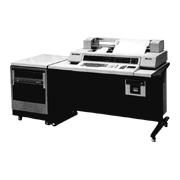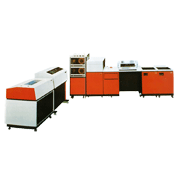The TOSBAC System 15 was an office computer(with a CRT, and was the first model to which Toshiba applied the name "Office Computer". (An office computer is a small business computer used in an office.)The series began with the announcement of the Model 10 and 20 in April 1977, and model enhancements like those indicated below were gradually made. These machines grew as a series which could handle a wide range of uses, and connected to the Kanji System 15 which came later.
- April 1977: Model 10, 20 (Floppy disk based)
October 1977: Model 30 (Magnetic hard disk based)
November 1977: Touch-In (Employed "touch-in" keyboard for code-less input
The CRT enabled a DDPS (Direct Data Processing System) for displaying input bills on the CRT, and printing results to the printer, while operating interactively. This greatly improved the accuracy and productivity of data processing.
The System 15 employed a distributed function architecture. The system was configured by modularizing system functions such as input/output control and on-premises connection line control, implementing them with microprocessors and firmware, and connecting the modules with a high-speed system bus. The keyboard/CRT terminals connected to the system were called "workstations", but these workstations also had built-in microprocessors, and had high-level intelligent capabilities such as transmission control, pre- and post- processing of input/output data and display control.
The Model 10 was equipped with a single-sided single-density floppy disk drive (capacity 243 kilobytes), and the model 20 was equipped with a double-sided single-density floppy drive (capacity 486 kilobytes). The Model 30, on the other hand, was equipped with a 10 megabyte or 30 megabyte magnetic hard disk drive. The Touch-In System, announced in 1997, replaced the JIS layout keyboard of the Model 10, 20 and 30 with a "touch-in" keyboard and code book, and this simplified entry of data such as customer codes and product codes.
| File units | Floppy disk drive | Single-sided single-density/Double-sided single density, Capacity 243/486KB |
|---|---|---|
| Magnetic disk drive | Winchester system, Capacity 10MB/30MB, Average access time 40msec | |
| Magnetic tape drive | 45ips, 2400feet/reel | |
| Cassette magnetic tape drive | 10ips, 800bpi | |
| Station units | CRT | 640char, 1920char, 2000char |
| Serial printer | Dot system: 100cps/150cps, Type system: 55cps | |
| Keyboard | Full keyboard: Standard JIS array Touch-in keyboard: 192items/page |
|
| Workstations | CRT: 640char, FDD, Dot matrix printer: 100cps | |
| Peripheral equipment | Optical character reader (OCR) | Document size: A4-A6, Max. 700char/sheet, Read speed: 2-20sheet/min |
| Line printer | 100-170line/min, 240line/min | |
| Card reader | 400card/min | |
| Paper tape reader | 200cps | |
| Paper tape punch | 50cps | |
| Communication controller | 200-9600bps, synchronous/asynchronous, automatic dialing |
The TOSBAC System 35 was developed as the successor of the TOSBAC-1350 Model III, with the aim of enhancing hardware and improving functionality/performance while maintaining program and data compatibility. It was announced at the same time as the TOSBAC System 15 and System 55 in 1977. The features of the System 35 hardware were as follows:
- Serial printer: Dual-direction printing, platen segmentation function (standard). Print speed: 100cps
- Magnetic disk drive: Magnetic hard disk drive, capacity 9.8 megabyte, average seek time 40ms
- CRT display: 12-inch, 80char x 24line
- Main memory: IC memory, 32 kilobyte
The TOSBAC System 55 was developed as the successor of the TOSBAC-1350 Model V, and was announced in April 1977. The System 55 had features like the following:
- Magnetic disk drive: Magnetic hard disk, capacity 30 megabyte, average seek time 40ms
Cartridge type: capacity 16.7 megabyte, average seek time 30ms - CRT display: 12inch, 80char x 24line
- Main memory: IC memory, 32-224 kilobyte
- Programming environment: COBOL
- Multi-programming system
- True online processing using COBOL
- Comprehensive job control capabilities




